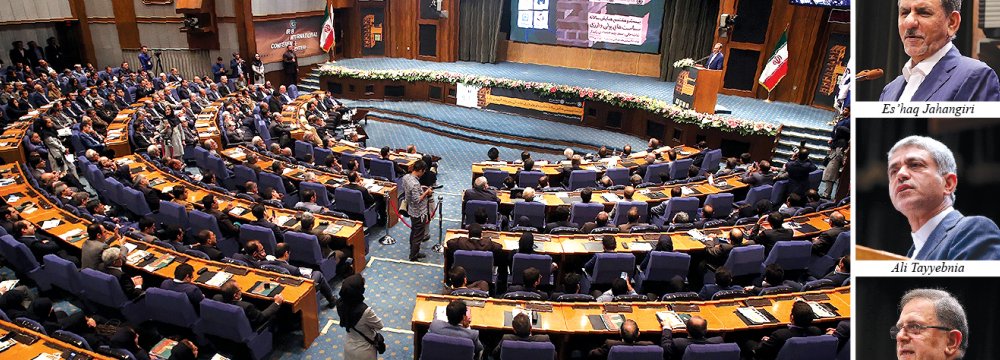The highly consequential issue of Iranian bank interest rates was the main topic of discussion in the latest event held in Tehran with a broad focus on financial stability.
Saturday marked the beginning of the two-day 27th annual Conference on Monetary and Foreign Exchange Policies with First Vice President Es'haq Jahangiri, Minister of Economic Affairs and Finance Ali Tayyebnia, Governor of the Central Bank of Iran Valiollah Seif, and CBI Vice Governor Akbar Komijani delivering keynote speeches.
Jahangiri referred to the administration of President Hassan Rouhani's general tendency of keeping away from reducing rates through official directives, but also noted that the current rates present challenges to investments, production, and macroeconomic endeavors.
After a round of negotiations and meetings last year between the CEOs of private and state-owned banks and a subsequent decree by the Money and Credit Council, a top financial decision-making body, bank interest and deposit rates were officially set at 15% and 18% respectively.
However, a number of factors, including a shortage of capital and credit crunch in the banking system, have caused the real interest rates currently offered by a number of banks to be around 20%. The interbank rates are also in the same ballpark even though, as Jahangiri pointed out, they have been brought down from the 30% witnessed at the beginning of the government’s tenure in Aug 2013.
Echoing the president, who last week announced that banking reforms will play a central role in his agenda for the second term in office, the first vice president said reforming the ailing sector is “one of the key policies” that could help the country overcome its significant hurdles.
A problematic 11% general unemployment rate and, more importantly, a troubling 25% unemployment rate among young graduates, coupled with the low purchasing power of people, were identified as major problems by the official.
“Iran will need to generate one million jobs a year to live up to the task,” he said, noting that women should be a main focus for the jobs.
According to Jahangiri, unifying the country’s dual exchange rates, a plan which was supposed to be implemented last year but has been delayed, because conditions for a stable and lasting rate unification are yet to be provided, will be followed up as a “high priority” in the next administration.
The economy minister referred to the high interest rates as a “significant obstacle to growth of investments and employment” and a “source of eroding stability”.
“The real rates, which are in no way proportional to the inflation rate of around 10%, have increased the costs of production units and lowered the competitive power of domestic production while lowering people’s capability of repaying loans, which itself reduces the profitability of lenders,” he said.
Tayyebnia underscored the importance of reducing the unruly interest rates for causing a boom in the beleaguered housing sector, stressing that getting the sector out of recession will not be possible without rate cuts.
Owing to the significance of rate cuts which, if unachieved, could dash all hopes of sustained growth and job creation, the official pitched the idea of creating a specialized committee “in the foreseeable future”.
The minister spoke of the advantages of the government’s plan to increase the capital of state-owned banks and improve their capital adequacy ratio, saying their total capital of 110 trillion rials ($2.93 billion) four years ago increased to 590 trillion rials ($15.73 billion) last year.
Furthermore, “100 trillion rials ($2.66 billion) of construction resources were supposed to be allocated for capital increase of banks as part of the current annual budget, which was not approved by the parliament”.
He urged all official bodies to prioritize bank capital increase because investing in the banking system has the biggest impact on economic growth.
Tayyebnia also provided statistics on the average GDP growth of Iran in the past 40 years, which he put at 2.3% and called inadequate.
The CBI governor made a jab at uncertified credit institutions that have grabbed many headlines recently, as many angry depositors demand their capital back from a number of these discredited entities.
Seif said their activities in the past few years have forced lenders to initiate “an unprincipled competition over bank interest rates”, which was exacerbated by the entry of bonds published by the government to clear its debts and subsequently affected their profitability and capital adequacy.
According to the official, the banking system allocated a total of 570 trillion rials ($15.2 billion) during the first two months of the current fiscal year that began on March 21, registering a 16.4% rise compared with the same period of last year.
About 70% of the loans were in the form of working capital, he added.
Seif also referred to statistics released by the central bank, according to which a 12.5% GDP growth was achieved last year, mostly owing to a boost in oil and derivatives exports.
“The non-oil sector has also improved immensely, upgrading its negative total GDP growth in the first quarter of last year to a positive 3.9%, 5.4% and 5.6% in the next quarters respectively,” he said.







Add new comment
Read our comment policy before posting your viewpoints